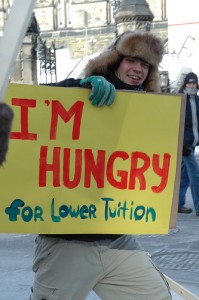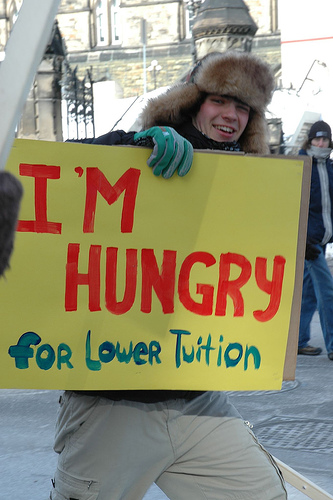 As waitlists at UFV continue to grow in the wake of the provincial government’s 2010 freeze on post-secondary education spending, British Columbia’s 2011 budget shows little relief for students and their families, once again putting the brakes on a much-needed increase in funding.
As waitlists at UFV continue to grow in the wake of the provincial government’s 2010 freeze on post-secondary education spending, British Columbia’s 2011 budget shows little relief for students and their families, once again putting the brakes on a much-needed increase in funding.
Canada’s public post-secondary institutions are the responsibility of their respective provincial governments. Without continued support from the province, B.C.’s colleges and universities will be forced to choose between quality and affordability. This would result in either significantly increased tuition fees, which would prevent thousands of aspiring students from enrolling in higher education, or critical cuts to teaching staff, class selection, educational materials, or equally important support service. Not to mention larger class sizes.
We live in a province with an increasingly knowledge-based economy that depends on educated workers. Yet stagnant spending on post-secondary education does not reflect inflation rates or increases in population and demand. Far from merely inhibiting growth or maintaining the “status quo,” to quote B.C. finance minister Colin Hansen in his presentation of this year’s budget, the check on education spending will cripple our current post-secondary institutions’ functionality.
The funding freeze is a reactionary measure to the recent economic downturn and such a move is incredibly short-sighted. Post-secondary education is a long-term investment with considerable social and economic benefits for both the individual and the community.
In his 1999 report for the Canadian Centre for Policy Alternatives entitled The Education Dividend, Oxford economics professor Robert Allen examined “the social rate of return” of education spending in British Columbia. He found that additional tax revenue generated by the increased lifetime income of post-secondary students amounted to a 10 percent return for the provincial government, should it absorb all costs associated with a degree or training program. This puts more money in the public treasury, benefiting the general population. Allen advocates running a small deficit to fund post-secondary education, writing that, “it is only good business,” to borrow at 5 percent for a 10 percent return.
Aside from the benefits to taxpayers, greater government subsidy of tuition helps bring equality to higher education, enabling eligible students from poorer families to attend university without having to take out massive student loans.
The prospect of finishing an undergraduate degree saddled with substantial debt is a key deterrent for many potential students in B.C., where the burden of costly unpaid student loans is common. According to the Canadian Federation of Students, the average student debt in British Columbia is $27 000, the highest in Canada outside the Maritimes. To combat this problem, a majority of British Columbians are looking for tuition relief.
In a 2010 B.C. poll commissioned by the Canadian Association of University Teachers and the Canadian Federation of Students, 85 per cent of respondents supported reduced post-secondary tuition fees.
Heavily-subsidized higher education is not only good for the long-term health of B.C.’s economy, but for the quality of life of all of its citizens. For example, doctors provide medical treatment, and those with Bachelor’s degrees can become teachers and instruct future generations.
It’s time for the B.C. government to make education at all levels a top priority. Only time will tell if recently elected Premier-designate Christy Clark will reverse this dangerous trend of inadequate post-secondary funding.


